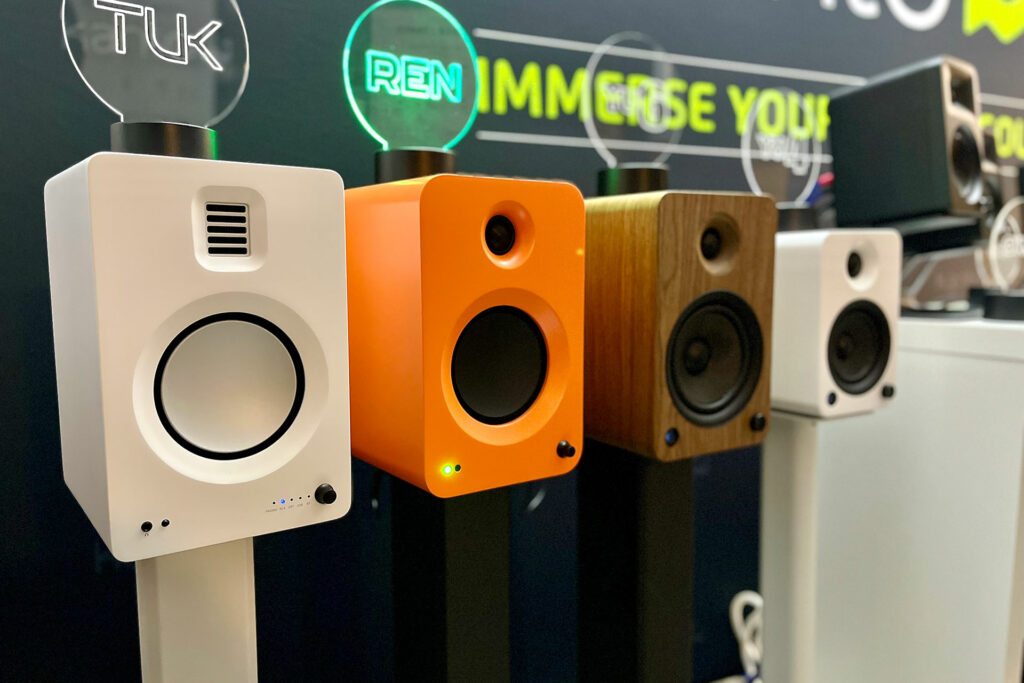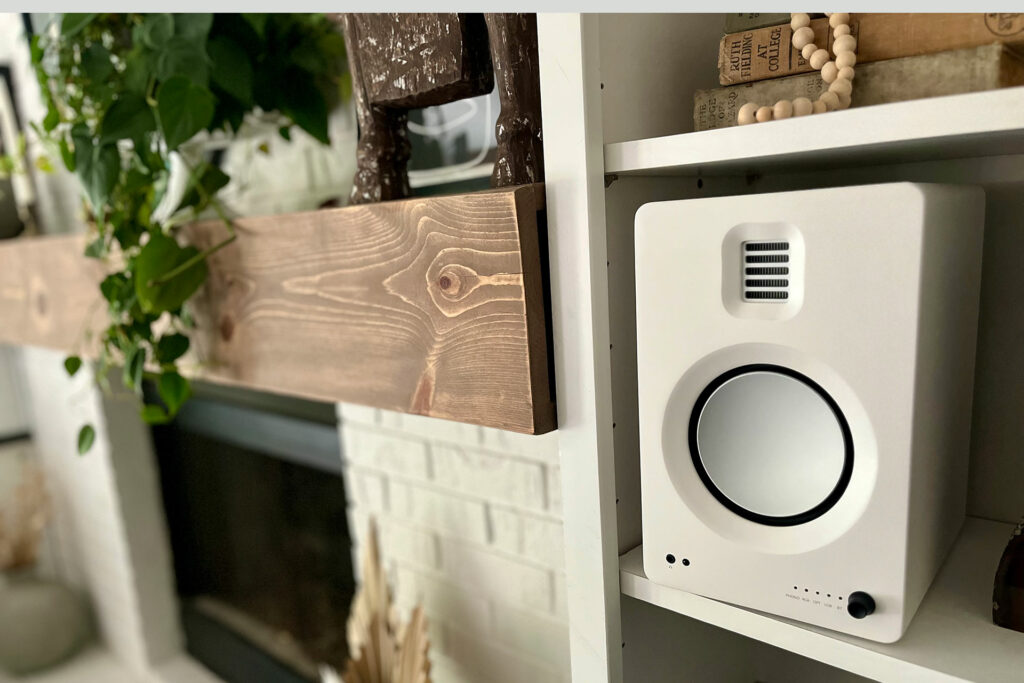The first time I heard Kanto speakers was in 2018 at the Axpona audiophile show in the suburbs of Chicago. The Canadian lifestyle consumer electronics brand had a modest setup in the convention’s lower marketplace area (typically reserved for smaller companies and brands who aren’t quite ready or able to lock in a spot amongst the hundreds of bigger, more established companies that show on the upper floors). Wedged somewhere between a headphone listening booth and the Comply Foam Ear Tips table, Kanto’s modest speaker lineup generated significant buzz and drew the attention of a disproportionate number of younger audiophiles thanks to their fun, unique designs and incredible sound quality for the price.
The contrast between Kanto’s presence at Axpona in 2018 versus 2024 was stark. This year, Kanto had an entire decked-out display room to themselves – and they needed it – to show off their impressive expanded lineup of passive and powered speakers, including their category-disrupting Kanto Ora desktop speakers (read our review). But most notable among them were the TUK Powered Bookshelf Speakers, which represent the higher end of their product catalog and feature some impressive sonic capabilities for their size and price. But, for $799, do the Kanto Audio TUKs offer enough to convince the audiophile community that a pair of value-oriented powered speakers can perform just as well, if not better, than similarly-priced traditional bookshelf speakers hooked up to an amp? Let’s delve deeper into the review ahead and find out.

What Makes the Kanto TUK Powered Bookshelf Speakers So Special?
- The Kanto TUK Powered Bookshelf Speakers employ advanced high-performance Air Motion Transformer (AMT) tweeters, which not only produce exceptionally bright and precise high frequencies, but also create an expansive soundstage and electrostat-like open overall sound. AMTs are not always the best choice in speaker design, as they can be prohibitively expensive compared to traditional dome tweeters and, when not implemented correctly, can lead to issues with harshness and horizontal dispersion. This was absolutely not the case with the Kanto TUKs, as I had them placed about eight feet apart in my listening space, and had minimal issues with off-axis listening, and the AMTs performed just fine, even at higher volumes. The AMT produced incredibly detailed, accurate, and quick high and mid-high frequencies, bringing my music to life in a way that I thought was only possible with systems costing hundreds more.
- The Kanto TUK Powered Bookshelf Speakers feature a 130-watt class D amplifier capable of producing 65 watts per channel. This is more than enough power to fill a medium-sized room, and the TUK Powered Bookshelf Speakers did so without breaking a sweat. At high volumes, the TUKs maintained clarity and precision and never showed signs of excessive resonance or rattling. While these speakers were fun to listen to, even at near-maximum volume, as a speech and hearing professional on a crusade to save the world one tympanic membrane at a time, I would advise against maxing out these (or any) speakers for a prolonged period, for your ears’ sake.
- The Kanto TUK Powered bookshelf speakers produce surprisingly strong bass for their size. The TUKs had no problem digging cleanly down into the low 50Hz range when placed eight inches from the wall, as per Kanto’s recommendations. The five-and-one-quarter-inch aluminum driver and impressive internal bracing allowed for clean, consistent, accurate bass, which was a pleasant surprise. This is worth noting, given that they are only seven inches wide, eight-and-a-half inches deep, and just under 11 inches tall. I had to pick up and move the TUKs around my listening room several times to make sure the bass coming out of these things was not some sort of placement anomaly. I also performed an A/B test with and without an eight-inch subwoofer and, in all honesty, could not discern a significant difference. This may be slightly attributed to the TUK’s digital signal processing (DSP) that favors low end, but it works – and makes them that much more fun to listen to in most contexts.
- The Kanto TUK Powered bookshelf speakers are easy to operate and can be customized to your listening preferences. Audiophiles love making things complicated (I am often guilty as charged), but for certain listening applications, simplicity is best. And while the TUKs lack some of the features found on newer and more expensive speakers (such as room correction or a dedicated app), the TUKs were refreshingly simple to set up. The TUKs were packaged nicely, with cables and cords for every potential connection – including a 10-foot long, high-quality speaker wire with banana plugs. This let me position my left and right channels at opposite ends of my living room, creating a wider soundstage. Additionally, they provided a straightforward remote with treble and bass controls, enabling me to equalize the speakers to suit my personal preferences and adjust each input as necessary.
- The Kanto TUK powered bookshelf speakers boast a sleek, minimalist design, available in both black and white finishes. The TUK speakers look great in nearly any listening environment and include magnetic grille covers for those who prefer a more discreet look – though their uncovered facade is well worth showing off. The silver, recessed driver and sleek AMT tweeter together create a stylish and modern speaker that looks much cooler than most other powered systems on the market today. Kanto also manufactures some attractive speaker stands that will further enhance the look. if their ultimate destination is somewhere other than a bookshelf or TV stand.
- The Kanto TUK features some decent connectivity options especially considering their price. The TUKs are Bluetooth-capable, and feature a built-in phono preamp that eliminates the need for additional equipment typically required for turntables, while a separate RCA input for line sources ensures that you won’t need to switch or share inputs between two analog audio sources. Kanto’s USB input supports up to 24-bit/96 kHz, providing a solid digital connection to your PC without needing an external DAC. Additionally, the optical input, also supporting up to 24-bit/96 kHz, offers a versatile digital connection compatible with TVs, PCs, and digital audio players.
Why Should You Care About the Kanto TUK Powered Bookshelf Speakers?
The idea that one could obtain an excellent-sounding two-channel HIFI system with no external amplification for under $800 would have been a preposterous argument 15 or 20 years ago. But with steady advancements in Class-D amplifiers, as well as improvements in driver technology, powered or active (sometimes used interchangeably) speakers are making their mark on the audiophile community and changing the way we build our systems. The Kanto TUK powered bookshelf speakers prove that great sound can be had within a reasonable budget, and do so with style. They are good enough to function as main stereo speakers in a HiFi setup, and would also be a great choice for the experienced audiophile looking for a hassle-free way to establish a secondary or bedroom system.

Some Things That You Might Not Like About the Kanto TUK Powered Bookshelf Speakers
- The Kanto TUK Powered Bookshelf Speakers lack a few of the bells and whistles seen in other powered speakers. The TUKs lack WIFI connectivity, so an external Chromecast audio or similar streaming device will be required if you plan on streaming wirelessly beyond Bluetooth. Luckily, I have multiple Echo Dots lying around, so this wasn’t an issue for me when employing these as part of my multi-room system. And while the TUKs do feature Bluetooth 4.2 with aptX HD codec support, the leap from Bluetooth 4.2 to 5.0 was a significant one in terms of bandwidth, energy consumption, speed, and stability, so it would have been nice to see a more future-proof version installed. Technically speaking, however, there is no difference in sound quality when comparing Bluetooth versions, so this is not a dealbreaker by any means.
Listening to the Kanto TUK Powered Bookshelf Speakers …
Teddy Swims’ single “Lose Control” is a well-produced, R&B/Motown/rough country-infused pop track with huge dynamic range and some fun sonic flourishes – perfect for auditioning a pair of fun speakers such as the Kanto TUKs. This song popped up while casually listening to a curated Top 40 playlist on QoBuz, so I gave it a shot and was immediately impressed by the expansive soundstage produced by the Kanto TUK Powered Bookshelf Speakers. One thing I love about this song is the inclusion and amount of big instrumentation – brass, Floor Tom drums, electric guitar. These elements blend well with Swims’ unique, gritty voice that certainly does not require autotune. The TUK speakers did an excellent job of letting me identify the textures of each instrument, including that of his voice, and allowed me to appreciate the various details of each. The DSP was on full display and colored the track just a little, pushing it slightly in the direction of bass-heavy – but not enough to reduce my enjoyment of the song (this was easily remedied by the included tone adjustment). This may scare off some purists, but I can say with confidence that even compared to my passive two-channel system, currently rocking the new SVS Ultra evolution bookshelf Speakers (read my review here), the Kanto TUK powered bookshelf speakers maintained a strong representation of the original track, albeit with Kanto’s signature sound attached – and that wasn’t necessarily a bad thing.
I allowed the power of my playlists to guide me for my next musical selection, and ended up at Sabrina Carpenter’s smash hit “Please Please Please.” This is another interesting, borderline musically weird pop hit that you’ve probably heard a million times by now, but I was immediately drawn to its nuanced use of synthesizers, combined with multiple key changes and sweet two- and three-part female harmonies. The intro features some cool throwback synth coloration and reverbed electric guitars that the Kanto TUKs clearly articulated. As the song progressed and morphed in and out of its various genre identities, the TUKs accentuated the finest elements of the song and allowed Carpenter’s poppy vocals to sound crisp and clean throughout. Even at high volumes, the female vocal harmonies featured on this track were never fatiguing or piercing – something I have experienced with lesser speakers in this category.
Will the Kanto TUK Powered Bookshelf Speakers Hold Their Value?
Kanto is an up-and-coming brand in the audiophile and lifestyle-tech space with a respectable social media following and rapidly growing client and fan bases. Their products are also relatively affordable, thus quite attractive to younger audiophiles, which bodes well for their potential future resale value. I’ve seen a few Kanto products on eBay and Facebook Marketplace, and they sell pretty quickly and without a significant amount of depreciation. I don’t see Kanto going anywhere (but up) any time soon, so brand recognition should only continue to increase – furthering the value proposition of their unique audio products. Your investment in some small audiophile-grade powered speakers is seemingly safe. Moreover, at these prices, it is isn’t too much money to lose as the opening ask isn’t that expensive.

Who is the Competition for the Kanto TUK Powered Bookshelf Speakers?
The SVS Prime Wireless Pro powered speakers are considered by many to be one of the best-sounding powered bookshelf speaker pairs under $1,000, and for good reason (check out our review). For $899, the Prime Wireless Pros boast 200 watts of Class-D power, an advanced crossover, HDMI with ARC/eArc, Wi-Fi, Airplay and Chromecast, as well as Bluetooth 5.0 and aptX. They are similar in size to the Kanto TUKs at 11.61 inches tall, 7.09 inches wide, and 8.96 inches deep, and the 5.25-inch mid-bass driver produces similarly deep, impactful bass, with a frequency response rating of 42Hz-25kHz. The look is a little more industrial, and the capable silk dome tweeter works well, but can’t match the brilliance of Kanto’s AMT. Nonetheless, they are a worthy contender and would be an excellent choice.
The KEF LSX II LT powered speakers are priced at $999 and offer crystal-clear sound and modern technology in a relatively compact package. KEF’s LSX line has evolved over the years, and its latest iteration is impressing audiophiles with its versatility, ease of use, and excellent sound quality. The LSX II LTs feature KEF’s signature coaxial Uni-Q driver powered by four separate Class-D amplifiers supplying 70 watts to each woofer and 30 watts to each tweeter. The four-and-a-half-inch magnesium/aluminum alloy woofer will never go quite as deep as that of the Kanto TUKs, and the Cyclops-style design might not be for everyone. These are excellent all-in-one speakers that would please most listeners; just be prepared to add a subwoofer for a complete listening experience.
The ELAC Debut ConneX Adsum are the cosmetically upgraded version of the ELAC Debut Connex DCB41 speakers. They feature a beautiful, modern aesthetic – compliments of their collaboration with Brooklyn clothing designer Adsum – and are outfitted with custom metal stands, a white gloss finish, and retro-style grilles. They aren’t just pretty – these are some feature-packed powered speakers that include Bluetooth with aptX, HDMI ARC, and an optical digital input, to name a few. They are the least-powered of the bunch, at only 50 watts per channel, but can produce bass as low as 50Hz, and their compact size (six-and-a-half inches wide, around 12.5 inches tall, and nine-and-a-half inches deep) allows flexible placement for a variety of listening applications.

Final Thoughts on the Kanto TUK Powered Bookshelf Speakers …
The Kanto TUK Powered bookshelf speakers met all my expectations, performing well in a variety of listening contexts. While many audiophiles may be hesitant to consider active or powered speakers for their primary listening spaces, I encourage those with an open mind to give these speakers a chance. The TUK speakers offer a perfect blend of simplicity and affordability without compromising on fidelity. Their ability to deliver clear, detailed audio – thanks in part to their incredible Air Motion Tweeter – makes them an outstanding choice for anyone seeking a premium listening experience without breaking the bank.
If you’re in the market for a versatile and stylish audio solution for your main listening room, bedroom, or office, the Kanto TUK Powered bookshelf speakers should be at the top of your audition list.




Nice Stuff 🤗
We agree.
Audiophile performance. Modern feature set. Reasonable price.
Do they have remote control ?
Yes! It comes with a nifty remote that you can use to control volume, inputs, power and even treble and bass presets, which are save-able.